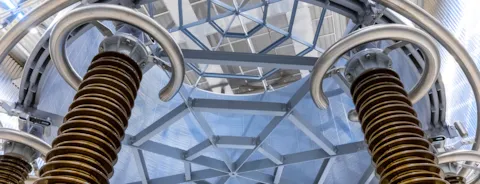DNV joint industry project calls for bold action from U.S. states to build out HVDC offshore transmission network
Success of the offshore wind industry relies on a functional, reliable and cost-effective transmission system
DNV, the independent energy expert and assurance provider, today issued a set of recommendations and a timeline to build a fully functional offshore HVDC transmission network to support U.S. offshore wind power goals. As the first phase of a joint industry project (JIP) exploring the feasibility of incorporating HVDC (high voltage direct current) transmission into the U.S. grid concludes, these guidelines emerge from extensive collaboration across the sector, incorporating insights from a multitude of stakeholders. An offshore HVDC transmission system will enable the reliable delivery of this clean electricity to millions of homes and ensure developers and investors achieve a secure return on their investments. This network is critical to achieving the Biden administration’s goal of bringing 30 GW of offshore wind power online by 2030.
The foremost recommendation from this study is for agencies, governor’s offices, developers, HVDC equipment manufacturers, and service providers to work together toward building an offshore transmission system that will unlock the full potential of offshore wind projects, meeting deadlines and budgetary constraints effectively.
Most imperative is an urgent need for states to focus on procuring 320 kV HVDC symmetric monopoles without AC or DC interlinks. This strategy not only safeguards ongoing project success but also secures continued public backing for offshore wind development. Leveraging mature technology and a larger fleet of vessels for offshore converter station transportation and installation, this approach minimizes risks, providing immediate benefits to existing and upcoming offshore wind projects while bolstering public trust in the industry.
The study also recommends a step-by step build-up of infrastructure that takes into account the global HVDC equipment market and recent procurements and partnerships in Europe that are driving the market. The phased approach to procuring and installing an HVDC transmission network is intended to overcome current barriers and create a clear pathway to an offshore transmission network. Participants in the JIP laid out short-, mid-, and long-term milestones for building a HVDC transmission network, starting with symmetric monopoles at 320kV, leading to a fully functional, 525 kV HVDC network with DC interlinks. Ultimately, the creation of a fully functional HVDC transmission network will maximize public benefits by increasing energy deliverability and enabling intra- and inter-regional power transfers.

Energy Systems North America at DNV
“It is crucial to the success of the U.S. offshore wind industry that state agencies and governor’s offices pay greater attention to market constraints and the evolution of offshore transmission technology,” said Richard S. Barnes, region president for Energy Systems North America at DNV. “The recommendations outlined by this consortium provides a clear pathway to a reliable, flexible, and cost-effective HVDC transmission grid which will enable states to achieve their offshore wind energy goals.”
Specific recommendations from the JIP include:
- Establishing a task force with industry and state participants to review the feasibility of AC mesh solutions given the significant supply chain constraints that have emerged since AC mesh solutions were first envisioned
- Enabling the connection of 525 kV HVDC bipole circuits from the Northeast through the Mid-Atlantic
- Investigating options to reduce the size and weight requirements of offshore platforms for 525 kV HVDC bipoles
- Defining the planning, operational, and functional performance expectations for DC interlinks between 525 kV HVDC bipoles
- Identify any points of interconnection and/or navigable channels that should be reserved for 525 kV HVDC bipoles.
DNV has been collaborating with businesses and governments for more than 90 years to ensure affordable, reliable, and sustainable grid operations. In September 2023, the U.S. Department of Energy awarded DNV the role of coordinating offshore wind and transmission developers, utilities, regional transmission operators, equipment manufacturers, and other key stakeholders to identify gaps in U.S. HVDC standards. Additionally, DNV coordinated the European Union’s Horizon 2020 PROMOTioN project to research, develop and demonstrate the key technologies and regulatory and economic frameworks essential for accelerating the deployment of meshed HVDC offshore grids.
